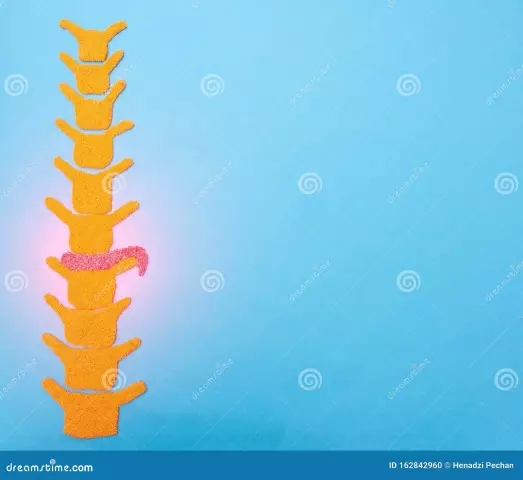- Author Curtis Blomfield [email protected].
- Public 2023-12-16 20:44.
- Last modified 2025-01-23 17:01.
Intervertebral hernia - a disease in which the fibrous ring of the intervertebral disc is torn, and the nucleus comes out. To understand the essence of the disease, it is worth knowing the anatomical features of the spine.

It consists of vertebrae, which are connected by special oval discs. They consist of an elastic "pulpous" core, which performs a shock-absorbing function, as well as a fibrous ring, which is strong enough to prevent the central part from protruding under the weight of the body.
Certain pathologies of the spine (for example, scoliosis, osteochondrosis or subluxations) cause a decrease in the elasticity of the intervertebral discs, which causes protrusion - hernia. This compresses the nerve fibers that come out of the spine, which leads to pain.

Intervertebral hernia: types
Depending on the size, this pathology occurs in the form of prolapse (protrusion is 2-3 mm), protrusion (hernia size is 4-15 mm), and also in the form of extrusion, which in the form of a drop extends beyond the intervertebral disc.
Causes of this pathology
Among the etiological factors that can provoke the development of an intervertebral hernia, the following can be distinguished:
- inherited structural features of the spine;
- weak muscle corset;
- infectious diseases;
- wrong posture;
- diseases of the spinal column, especially osteochondrosis.
A herniated disc can also occur due to sudden movements, excessive physical exertion, back injuries and other negative factors.
Most often this pathology develops at the age of 20-55 years. Among older people, this spinal lesion is less common, as their nucleus pulposus loses its elasticity.
Herniated disc: symptoms
This disease is accompanied by a narrowing of the spinal canal, which leads to compression of the nerve roots. At the same time, the surrounding tissues swell and become inflamed. The patient experiences pain, which is localized not only at the site of the hernia, but also along the nerves emerging from the spinal cord. In addition, pain can also occur in areas of the body that are innervated by the affected roots. Patients also complain of incoordination and changes in muscle strength.
It is worth noting that most often such pathological changes in the spine occur in the lower back, although they can also develop in the cervical region.
Intervertebral hernia: treatment methods
Therapy of this disease is carried out in two ways: conservatively and through surgery.

Conservative techniques are aimed at reducing pain, swelling and inflammation, restoring the functions of the spine, sensitivity and muscle strength of the affected areas. Treatment of intervertebral hernia without surgery involves the use of reflex methods - acupuncture, vacuum therapy, pharmacopuncture, etc.
The operation is carried out with the ineffectiveness of conservative treatment. At the same time, the pathologically changed disc is partially or completely removed.






